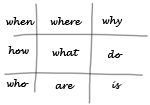Introduction
This section aims to prepare students for the kind of questions to expect in part one of the speaking test, giving them lots of opportunity to practise answering questions on a range of topics.
Preparation for part 1 – questions on familiar topics
Brainstorming pyramid
- Ask students what they think ‘familiar topics’ means and elicit ideas, e.g. family, hobbies, etc.
- Ask students to write down as many topics as they can in three minutes on their own.
- After three minutes students compare lists and make a new more comprehensive list together.
- Repeat exercise in groups of four, i.e. two pairs.
- Groups feedback lists to class and a class list is made.
A final class list may consist of some of the following topics:
my family, hobbies, job, my school, accommodation, my town, my city, my country, learning English, important festivals, food, music, what I want to do in the future, where I live, ambitions for the future, transport, TV, reading, travelling, etc.
Preparing questions
- Elicit from students question words beginning with the letter ‘w’, i.e. when, where, why, what, which,etc and those that do not begin with ‘w’, i.e. . how, do, are,etc.
- Select a topic from the class list in activity 1, e.g. free-time.
- In pairs, students prepare a list of questions on the topic using the question words already mentioned.
- Give an example for instance: What do you like doing in your free time?
- Go round the class and check questions are correct (for this activity different pairs of students could work on different topics and then you could compile a list of class questions).
A possible list of questions:
- What do you like doing in your free-time?
- How often do you…?
- Where do you….?
- Do you need any special equipment to….?
- Why do you enjoy…?
- Who do you…..?
- When do you….?
- Is it expensive? etc.
Now your students have a list of corrected questions, possibly on one topic or maybe several topics. There are many ways in which you could get the students to practise asking and answering the questions. Here are some suggested activities:
Simple role-play: One student takes the role of the examiner, the other the candidate and then swap roles using the same topic or a new topic.
In the hot seat: Not for the nervous types! Ask for a volunteer student to sit at the front of the class. Other students in class fire questions at him/her at random from their previously written lists or use new questions to try out. You could also do this activity in small groups in order to be less intimidating.
Noughts and crosses: Draw a grid on the board with nine squares. Place a question word in each square as follows:

Demonstrate how to play noughts and crosses, i.e. one person is crosses (student X), the other noughts (student O). Students take it in turns to choose a square. Crosses start first. The aim of the game is to get a straight line diagonally, horizontally or vertically before your partner does.
To play the game student X chooses a square, e.g. the centre square with ‘what’. The other student now asks a question on the given topic beginning with the word ‘what’. For example: What do you like doing in your free-time? Student X must answer the question. If student O is satisfied with the answer then student X can mark the centre square with an X. Now student O chooses a square and so on until one student wins the game or a stalemate is reached. Repeat game for different topics, they could play best of three or best of five if you wish.
Around the class: Choose a topic, e.g. food. The first student in the group asks their adjacent student a question, for example: What kind of food do you like? The student answers the question then in turn asks the next student another question, e.g. What do you find easiest to cook? and so on around the whole class.
Question tennis: This activity is a variation of the above but instead of carrying out the exercise going round the class you give the first student a ball (possibly one made out of screwed up paper, this is safer!). The first student asks a question and then throws the ball to any other student in group. That person must answer the question and then ask another question on the same topic and throw the ball to another student, and so on.
Feeding back on question and answer activities
- Focus on fluency– allow students to carry out activities without correction – get them speaking and build confidence.
- Focus on accuracy– Walk round and monitor pair work/group work – make a note of important mistakes – record straight onto board, do error correction after finishing the activities. This way you don’t interrupt activities and you also focus on mistakes as a class but anonymously! Do remedial language work if necessary, possibly at a later date. Another possibility is to integrate some written work into feedback as follows:
10 minute writing exercise: Who am I talking about? (a feedback activity)
After pairwork activities, each student writes on a piece of loose paper a short summary of what their partner talked about without saying who that person is. Collect in written work. Distribute randomly back to the class. Each student reads out the piece of written work given. Rest of class has to guess who the short text is written about.
Credits
,
IELTS: Speaking
- 1
- 2Currently reading
IELTS: Speaking test: Preparation for part 1
- 3
- 4




No comments yet